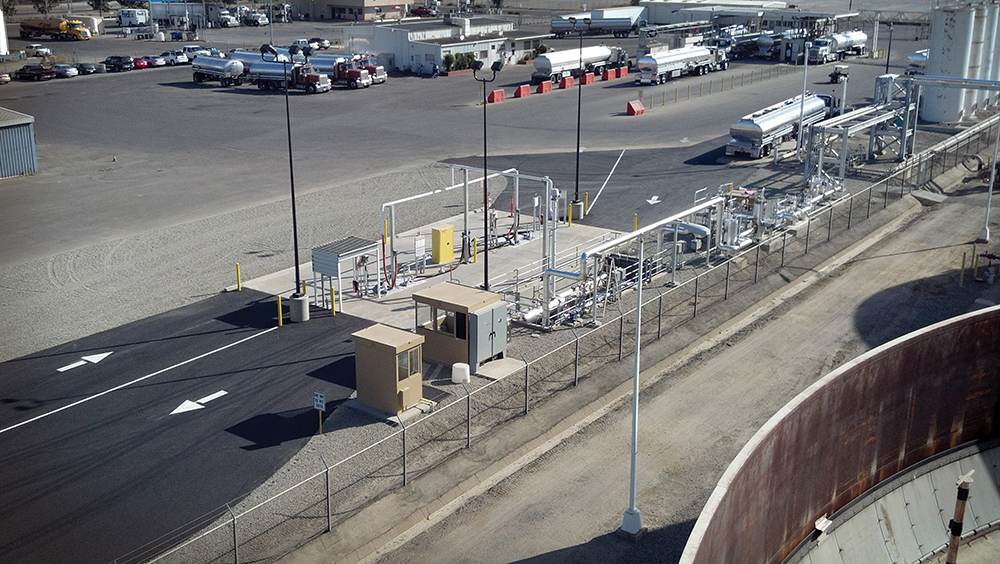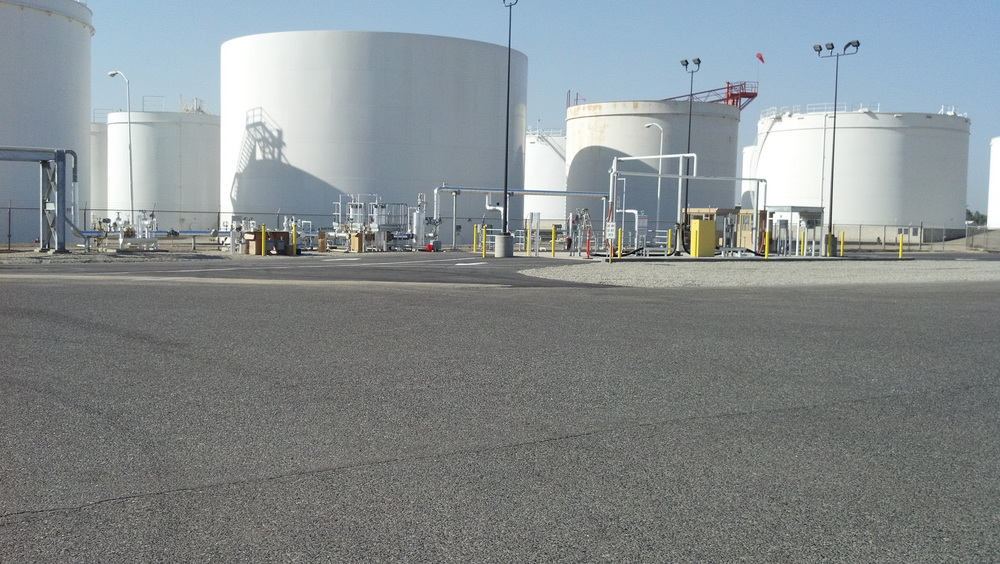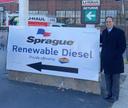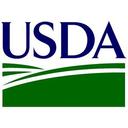Blend, Baby, Blend!



PHOTO: KINDER MORGAN
July 10, 2013
BY Ron Kotrba
In the U.S., people often say state biodiesel incentives are a backstop to the federal renewable fuel standard (RFS) and, in many cases, they also drive where biodiesel blending infrastructure is installed. Incentives to blend biodiesel vary from usage requirements, such as those in Minnesota and Pennsylvania, to tax breaks and exemptions found in Illinois, Texas and other states. And then there is California’s low carbon fuel standard (LCFS), a unique, climate-change-driven standard, mired in court battles but thought to be the single largest emerging biodiesel market today.
“I certainly see that it’s weak in states that don’t promote its use,” Jess Hewitt, CEO of Texas-based Gulf Hydrocarbon Inc., says of terminal biodiesel blending. “So what you get is this characterization, a few terminals in Texas have it, a lot of terminals in Illinois have it, but not that many others unless they’re mandated like in Minnesota or Pennsylvania. But with economics being what they are, most obligated parties would prefer blending millions of gallons that would be going into barges or a pipeline. That’s their preference, because it doesn’t involve quite the sophisticated infrastructure that inline blending at a terminal requires.”
Doug Meyers, business development director for Kinder Morgan’s West Coast assets, knows pipelines as much as anyone. Since late 2012, Kinder Morgan has installed biodiesel blending operations at four of its West Coast terminals, in Fresno and Colton, Calif., and in Las Vegas and Phoenix. The Colton and Fresno terminals are fed by pipeline, and feature heated and insulated tanks and piping. Meyers says the company made the decision to invest in biodiesel blending in California to satisfy demand created by the LCFS, but until just recently, it has not been easy to for its customers to find enough regional biodiesel supply to make the capital expenses worthwhile for the midstream giant. Kinder Morgan spent about $5 million at each of the four western terminals to outfit for blending. Combined, they can blend roughly 5 million gallons of biodiesel a month. “I think it’s safe to say that initial business started out slower as a result of the lack of B100 supply on the West Coast,” Meyers tells Biodiesel Magazine. “But we’ve since seen demand for the product drive additional sourcing and distribution supply chain of B100. Over the past several months, our customers have sought out and secured many more different supply options of B100, and we’ve seen the blending activity increase dramatically since the beginning of the year.” He says regional producers are ramping up production, and biodiesel is also being railed from the Midwest to transloading facilities near the California terminals, where it’s offloaded onto tanker trucks that deliver product to Colton and Fresno.
It’s the customer’s job to source the biodiesel, purchase the product and to hold it in their inventories at Kinder Morgan’s facilities. Kinder Morgan is a service provider and charges fees for offloading, handling, storage and blending B100. “We are not in the blenders credit business, the RIN business, or the California LCFS business,” Meyers says. Services rendered are how Kinder Morgan makes its money in biodiesel—mostly. The company does have transmix facilities where comingled product interfaces (gas and diesel) from pipeline batch deliveries are separated via distillation back into salable product. “In that respect, Kinder Morgan is an obligated party, we have RIN requirements for doing that,” Meyers says, “and also at some of our operations we blend both biodiesel and ethanol on our account, because we do hold product, and as a result we generate RINs ourselves. So, internally, Kinder Morgan does have a process center where we do generate RINs and have the ability to market those as well.”
Meyers says obligated parties get a “double bang for their buck blending in California terminals” because not only do they capture separated RINs—perhaps alone not motivation enough to blend biodiesel, according to Hewitt—but they can also generate LCFS carbon intensity credits. “I don’t know that anybody would be willing to [blend] biodiesel for the RINs, because they can always just buy the RIN,” Hewitt says. For LCFS credits, Meyers says that all takes place upon entry into the terminal. “A customer who brings in a load of animal fat B100 would get credit for that, the paperwork and reporting would be done upon entry into our terminal on those bills of lading,” he says.
Kinder Morgan recently enacted a process at its blending locations to help increase the amount of overall blending. “A customer can not only blend their own personal batch of diesel coming into our terminal, but they can also opt to blend diesel into our terminal where other customers have opted not to blend,” Meyers says. “We call it discretionary blending.” Schedulers record all individual batches into the terminal and know if a company has a 10,000-barrel (420,000-gallon) batch of diesel they aren’t going to blend. “The necessary arrangements can be made so the obligated party blender has the option to take advantage of that blend,” he says. “They make out and generate incremental RINs and Kinder Morgan makes out because we increase blending at our facility.”
Advertisement
Advertisement
Gulf Hydrocarbon rents tanks and stores B99 for blending in two terminals, the Buckeye terminal in Hartford, Ill., and Lone Star terminal in North Houston, Texas. “In Illinois, the state offers an exemption for a blended product that’s 11 percent or higher biodiesel, so that’s a tremendous incentive,” Hewitt says. “That’s a big incentive in Texas too. If biodiesel is used in diesel engines, then the biodiesel content is also exempt from state excise tax of 20 cents per gallon.” Lone Star is outfitted with inline blending at the rack, but the problem is there’s no diesel fuel stored there to blend with, thanks to competitive forces, Hewitt says. “There’s another terminal down the street and it’s [run] by the pipeline operator, so it’s very difficult for someone to justify the pipeline tariff to get in there,” Hewitt says. “I think the pipeline tariff is running about 1.5 cents and, in this business, that’s a lot of money.” In Hartford, Gulf Hydrocarbon’s biodiesel tankage is segregated from the rest of the diesel terminal, so splash blending is also the only option there. At Lone Star, customers bring in a tanker of diesel and splash blend biodiesel over top.
Blue Sun Biodiesel has a production facility in St. Joseph, Mo., and in January 2012 Blue Sun made its first sale from biodiesel blending at the Cummins terminal in Knoxville, Tenn. The company doesn’t ship its biodiesel to Knoxville though; rather, it sources more local supplies. Business Development Director Randy Rutherford says Blue Sun has a 13,000-barrel (546,000-gallon) heated, insulated tank dedicated to biodiesel storage in Knoxville. The tank, already insulated when Blue Sun took it over, is heated with a recirculating loop, meaning a pump circulates the biodiesel through a heater and then back into the tank. “We have 10-micron filtration going into and out of that tank into the loading rack,” Rutherford says. “All of our lines, including the filters as well, are heated and insulated.” Blue Sun offers biodiesel at three of the terminal’s six diesel loading lanes with two meters for biodiesel at each lane. “Cummins terminal uses a General Atomics terminal automation system that provides quite a bit of flexibility and robustness in the various ways that biodiesel can be blended at that terminal, meaning with our diesel or with our customers’ diesel,” he says.“Everything is ratio blended up to a B20, beyond that the terminal can load B100 with diesel fuel on top.” The Cummins terminal is unique, Rutherford says. “It’s actually two terminals, they have their own specific facility for just distillates, and at that diesel facility there are six lanes, so they do an awful lot of volume and they move the trucks through very quickly,” he says. “I think that by having two biodiesel meters per lane, it gives Blue Sun and Cummins the opportunity to load quickly and efficiently.”
Kinder Morgan’s Fresno and Colton terminals utilize manifold blending. Meyers explains how this works. “A Chevron or Shell customer of the world would have a batch of diesel coming over our pipeline,” he says. “We deliver it into our terminals at Colton and Fresno and what we’ve done is install a biodiesel blending system at the incoming manifold for the pipeline that leads into our terminal, so as the diesel batch gets delivered on the pipeline and comes into our terminals to be routed into a storage tank, we flip a switch and it’s injected in a stream that comes into the terminal with 5 percent B100, so what ends up in the storage tank would be a B5 product.” All of the diesel storage at Colton and Fresno has been converted to B5 storage, so it’s no longer possible at those facilities for a distributor to pick up clear diesel there. It’s all B5, and 5 percent is all it blends at those facilities. “If a customer really wants to blend more than that, they would have to take it offsite and increase the blend percentage on their own,” Meyers says, adding that the operation was constructed to dial up the blend rate if a majority of its customers express that desire. “Right now, a lot of the B5 blend rate is driven by the fact that as long as you have a B5 or less in the diesel that goes into a retail service station, it doesn’t have to be reported, or advertised, or marketed any different,” Meyers says.“But once it goes beyond 5 percent, you have a whole slew of additional reporting and tax requirements and other issues that we don’t get involved with—and we don’t want to at this point—so we just do a B5 blend.”
Blending at Kinder Morgan’s Las Vegas terminal came online in April and features rack blending. “The economics of blending in Las Vegas is determined solely by the RIN requirement, along with the blenders credit,” Meyers says. Biodiesel is blended at the truck rack into the truck compartment, so the truck driver pulls up to the loading rack, punches in the correct code to get 2, 5, 10 or 20 percent biodiesel, and two independent streams deliver the specified percentage into the truck, Meyers says, adding that rack blending gives much more flexibility to dial up (to B20) or down the percentage. “There are some municipalities in the Las Vegas area that require public vehicles to use B20, so the terminal has the ability to do that,” Meyers says. “We would like to have had that flexibility at all our terminals, but the cost is very prohibitive.”
Like in Colton and Fresno, manifold blending is utilized at Kinder Morgan’s latest blending terminal in Phoenix. The difference is Arizona state regulations require precisely known quantities for biodiesel going out over the loading rack. “In California and Nevada, they don’t care,” Meyers says. “As long as its 5 percent or less, it goes out as ‘may contain up to 5 percent,’ but in Arizona if it’s 2 percent, they want to know, if it’s 5 percent, they want to know.” As a result, the Phoenix infrastructure is more complex and more expensive than the others. “It left us with the ability to segregate Phoenix into both blended biodiesel and clear diesel storage,” Meyers says, “so we actually have both products available there.”
Advertisement
Advertisement
For measuring quantity, Hewitt says the biodiesel industry prefers scales because they’re used in agriculture. “But scales have a problem in many cases because they don’t offer a method of overfill protection,” he says. Without metering and overflow protection, usually a visual inspection is needed, which means the driver has to get on top of the trailer, open the hatch and watch it fill up, and someone else has to start and stop the pump. “The petroleum industry doesn’t do that, except on occasion with jet fuel,” Hewitt says. “For the most part they have automated meters that are temperature compensating and have overfill protection. These are electrical connections on the trailer where each compartment in the trailer has a high-level trigger that, when activated, sends a signal that shuts down the pump. It’s a much safer way of loading and can be done in any kind of weather. It produces the same result with a record of what’s going into the truck. It’s a safety matter too.” North Star uses a Scully overflow protection system.
Hewitt also says terminals should be equipped with separate lines for incoming and outbound product so receiving and delivering fuel can be done simultaneously. “To us, that’s extremely important,” he says.
Blue Sun, like most biodiesel blenders and midstream holders, requires thorough product testing from new suppliers. It analyzes samples at its biodiesel lab in St. Joseph, Mo. Then, when the supply is actually physically railed to a Knoxville area transload facility, Rutherford says samples are taken and shipped to St. Jo where the lab turns results around in 24 to 36 hours, usually before the fuel, taken by truck from the transload facility to the terminal, is offloaded into storage.
According to Hewitt, a must-have test for a terminal is the specific gravity test. Without it, “a terminal may not know if they’re receiving a load of glycerin or a load of biodiesel,” Hewitt says. “Generally what we do is give the terminal a range of acceptance.” Specific gravity of biodiesel can be measured with a hydrometer. Gulf Hydrocarbon also employs the pHLip test, a simple visual test created by Randal von Wedel with Cytoculture International Inc.
Kinder Morgan has a single national product spec for B100, Meyers says, so what’s required for the winter in New York is what’s required for the summer in Las Vegas. At the terminal, as the truck pulls up, a sample is taken and tested in the sample shack right next to the offloading facility. “It’s all in-house, it takes about 20 minutes,” Meyers says.
The success of a terminal blending operation, no matter the technology, location or equipment, depends on the staff that established and runs it, says Rutherford. “In addition to the technology, and some of the equipment that’s onsite at a particular terminal, the staff—the personnel and the management—all play a key role as far as their understanding of blending and, more specifically, biodiesel blending, to really help drive the questions that need to be asked in order to find the right solutions from those technology providers.”
Author: Ron Kotrba
Editor, Biodiesel Magazine
218-745-8347
rkotrba@bbiinternational.com
Related Stories
Montana Renewables LLC has delivered its first shipment of 7,000 gallons of SAF to Dearborn, Michigan's Buckeye Pipeline facility. From there, the fuel will be transported to the Detroit Metropolitan Airport via pipeline for use by Delta Air Lines.
NYC took a monumental step towards clean air and a sustainable future on Jan. 11 with the grand opening of the city's first retail fuel station dispensing renewable diesel. The project is a collaboration between Sprague and Sonomax.
The USDA on Jan. 11 awarded $19 million under the Higher Blend Infrastructure Incentive Program. The grants will support projects in 22 states to expand the availability of higher ethanol and biodiesel blends.
Jet Aviation partners with World Fuel Services to offer SAF in Bozeman, Montana, and Scottsdale, Arizona
Jet Aviation announced on Dec. 22 that it has signed an agreement with World Fuel Services to secure and offer sustainable aviation fuel (SAF) on-site at its FBOs in Bozeman, Montana, and Scottsdale, Arizona, effective immediately.
Neste has partnered with Coleman Oil Company, a leading provider of fuels, biofuels, lubricants, and related products, to enable cities and businesses to have easier access to Neste MY Renewable Diesel in the state of Washington in the U.S.
Upcoming Events










